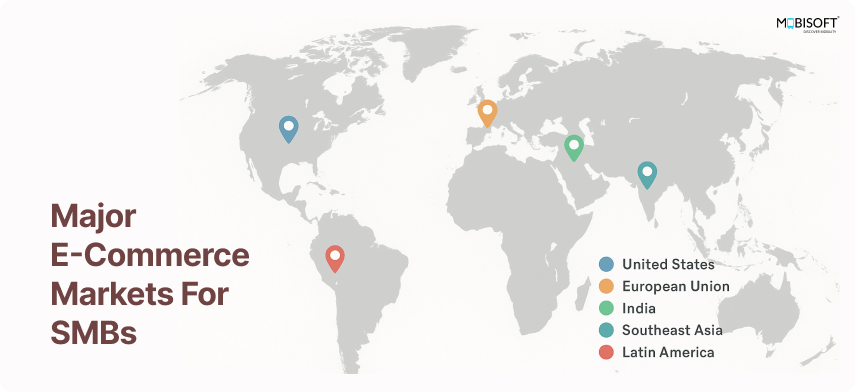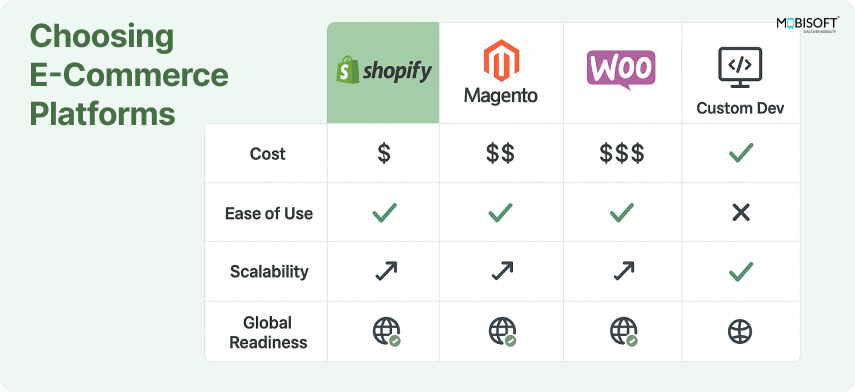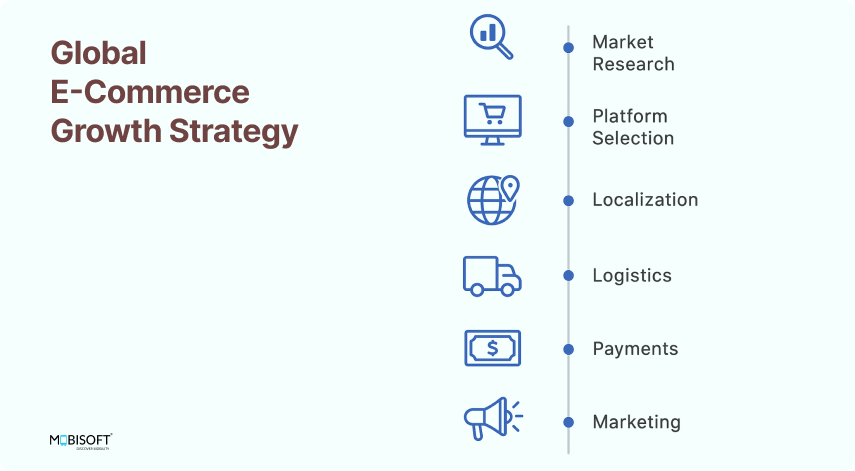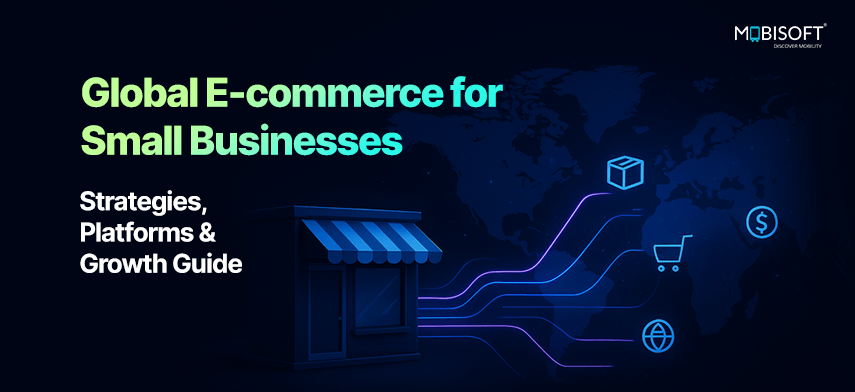Why E-commerce Matters for Small Business E-commerce Worldwide
E-commerce has quietly changed how business gets done. For small and mid-sized businesses (SMBs), it’s now a practical way to reach more customers, expand beyond borders, and run operations more smoothly.
What used to mean trusting a shop on a single street can now reach anyone, anywhere. Starting an online business can be daunting. Many business owners worry about costs, tech requirements, or just where to begin. Those concerns are entirely founded.
Here’s how you can do it. With the correct tools and a step-by-step process, thousands of small business e-commerce ventures, from local makers in Southeast Asia to family-run stores in Latin America, are succeeding online without wasting significant time or money.
This guide shares real e-commerce solutions and strategies that work. It is based on what businesses are doing right now, using accessible tools, and focusing on what matters: building a brand that lasts.
To explore more tailored digital approaches, you can check out our retail and e-commerce technology solutions designed specifically for SMBs.
E-commerce Growth Worldwide: What Global E-commerce Means for SMBs
People around the world are buying online more than ever before. Global e-commerce purchasing habits are growing exponentially across Asia, Africa, and the Americas. That change is an opportunity, but it also brings its interest and pressure.
Sometimes it's easy to feel like the big guys are always one step ahead; maybe the logistics seem too complicated. Maybe selling across borders through cross-border e-commerce seems out of reach. But there are small businesses that make it work.
Digital opens new boundaries. You’re not limited to selling in your neighborhood. You can expand into new markets, engage audiences to speak to specific audiences, and grow incrementally, even in small ways.
What matters most? Control. E-commerce business models give small businesses freedom. You decide how your e-commerce website development looks, how you talk to customers, and how fast you grow.
You don’t have to scale fast. You just have to scale smart.

Real Brands. Real Wins in Global E-commerce Sales

Let’s take a closer look at how some brands made it work. They started with a clear understanding of what their customers need, and built from there.
Jumia (Africa)
Jumia recognized that every one of its markets faced its challenges as well as issues related to trust, cash payments, and logistics of delivery. They didn’t try to change customer habits overnight. Instead, they worked with them. Cash-on-delivery became an option. Local warehouses were set up, making orders quicker to process and easier to deliver.
Shopify Merchants (Global)
From a small skincare brand based in Europe to a handcrafted furniture storefront in India, Shopify powers thousands of growing businesses worldwide. These sellers leverage their communities, share authentic stories, and keep showing up for their customers one order at a time. It has become a go-to global e-commerce platform for many entrepreneurs.
Shein (China-origin, global scale)
Shein didn’t grow by pushing products. They paid close attention to what people wanted. They used data to stay quick, kept prices sharp, and leaned into mobile-first shopping. That focus helped them reach young buyers worldwide, showing how global ecommerce sales can scale quickly when strategies align with demand.
These stories are about being responsive. These brands listened, adapted, and built trust, one step at a time.
Getting Started Without Burning Through Cash: Practical E-commerce Solutions for SMBs
Worried about the cost of getting set up? You’re not alone. Many small business owners hesitate because they assume going online means hiring developers and spending heavily. Skip building everything from scratch.
Use e-commerce platforms that already manage the hard parts, payments, security, and scalability. Begin small, test your market, and expand only when sales prove it’s worth the push.
Many SMBs also benefit from custom-built e-commerce platforms that are designed to fit their unique business models and growth needs.
Platforms to Know (Global-Friendly): Best E-commerce Platforms for Small Business

Shopify
Quick to launch and easy to run, Shopify comes packed with integrations. It’s ideal for testing a new market without waiting months to get started. Built-in currency conversion and multilingual tools make international e-commerce faster.
BigCommerce
Strong international features for tax, shipping, and regional storefronts are built in. You won’t need to juggle multiple plugins just to sell in different countries, making it one of the best e-commerce platforms for small business.
Ecwid
If you already have a website, Ecwid lets you start selling almost instantly. It connects with Facebook, Instagram, and even marketplaces like Amazon. Perfect for ecommerce global solutions that integrate into existing channels.
WooCommerce
A great choice for WordPress users. With the right plugins, you can tailor everything, from local payment methods to detailed shipping rules. WooCommerce supports global ecommerce solutions for businesses aiming to expand internationally.
If you want a complete setup, end-to-end e-commerce development services can help streamline your operations from launch to global expansion.
Tools to Simplify Work in International E-commerce
Stripe or PayPal
These handle secure global ecommerce payments and take care of currency conversion quietly in the background. Offering familiar payment methods helps customers feel more confident.
Zoho or HubSpot CRM
Track leads, automate follow-up emails, and store customer history without needing a large sales team.
Google Analytics & Search Console
These do more than report traffic. They reveal which products sell best in each region, where customers drop off, and which keywords drive them in.
Handling all aspects of your e-commerce business on a manual basis can quickly zap your energy. Automation can handle orders, inventory, follow-ups, and compliance, allowing you to focus on what really matters, like marketing and partnership cultivation.
To further enhance personalization and customer engagement, businesses can also adopt AI-driven e-commerce personalization tools, which make it easier to deliver customized shopping experiences.
How to Win in the Global Market: Cross-Border E-commerce Strategies

Going global is about making people in another country feel like your store was made for them.
Here’s what works:
Go mobile-first
Most shoppers worldwide use smartphones. Your site should be fast on slow networks, clear on small screens, and easy to check out with a thumb.
Offer multiple payment options
In some countries, digital wallets dominate. In others, cash-on-delivery still wins. Match your payment methods to the region.
Think regional
What sells in Germany might flop in Thailand. Understand local buying habits, holidays, and even cultural color preferences.
Use localized content
Go beyond translating words. Use local currency, familiar visuals, and region-specific promotions.
Partner with delivery networks that reach beyond big cities
Many of the fastest-growing global e-commerce markets are in rural and semi-urban areas.
Winning international e-commerce is about tailoring experiences to people in each market. To navigate international expansion smoothly, SMBs should also follow cross-border e-commerce best practices, which help reduce risks and build customer trust.
The Road Ahead: E-commerce Trends and Global E-commerce Experts to Watch
The space is moving fast. Here’s where attention should go next:
Mobile-Driven Shopping
In parts of Asia, Africa, and Latin America, the phone is only a screen. Make sure your store runs smoothly on mobile from first click to checkout.
AI, Automation & Smart Tools
AI now handles product recommendations, customer support chats, and stock alerts. You don’t need a big budget to access these, many come built into affordable e-commerce platforms.
Social Commerce
People are buying straight from TikTok, Instagram, and Facebook without ever visiting a store site. If your brand is visual, create content that sells right in the feed.
Sustainability Matters
Eco-conscious customers want to see proof, not promises. Show your sourcing, packaging, and shipping practices. Brands that back up their claims earn stronger loyalty and are often recognized as global ecommerce experts in responsible growth.
For a smoother customer experience, many SMBs rely on mobile e-commerce app solutions that deliver speed, scalability, and seamless integration.
Conclusion: Why Global E-commerce Is the Future for Small Business E-commerce Growth
Global ecommerce has leveled the field. With the right e-commerce solutions, small businesses can reach customers worldwide without huge budgets or big teams.
If you’re planning to sell across borders, our guide on cross-border e-commerce best practices will help you avoid common pitfalls and optimize operations.
The tech barriers are lower than ever. Today’s global ecommerce platforms make selling internationally simple, affordable, and scalable. All you need is a clear strategy, consistency, and the flexibility to adapt as you grow.
Right now, customers are exploring new brands, looking for great experiences and shared values. If you’ve been waiting for the right time to expand globally, this is it. Start lean. Test, learn, adjust. And build an e-commerce business that works anywhere your customers are.





 August 18, 2025
August 18, 2025


